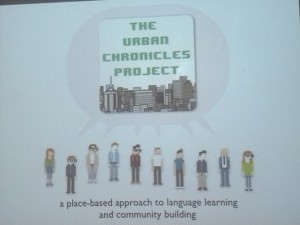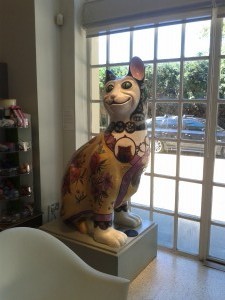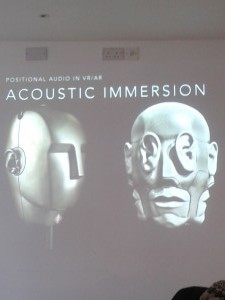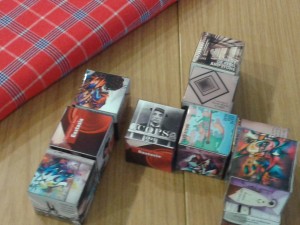As a group, students from the TESOL Diploma and Masters in TESOL attended a digital innovation workshop to encourage us to use technology in the classroom. The workshop leader, Paul Driver, an experienced EFL teacher and technophile, suggested using Brighton for class activities but primarily talked about the projects that he has created. If using apps Paul recommended using a pre-exercise app teaching session. Texting is another option, sending messages to students all round the city. Students would be able to use recording devices for narratives which could be checked and corrected, if necessary, later on. Students can take photos to support their reports. Students can also produce video recorded projects and finish by writing reports.
The Urban Chronicles Project was designed by Paul to look into the lives of local people. Although the project is currently on hiatus similar ideas could be put to work in any area around a language school. The seminar speaker, Paul Driver, talked about students’ social realities that can be created through technology. Walker & White, suggest making a digital guide book, for which Brighton, as a tourist City, is ideal. However in the classroom it might be better to work on content and suggest students use the information to create a small booklet guide to Brighton. This could easily be produced on a number of different desk top publishers or even as a paper form.
Artefacts from The Brighton Museum: Ideal for storytelling narratives around Brighton.
Maps of Brighton could be used for geo-tagging creating geo-tag memories for the students. One particular app called yellow-arrow allows students to use viral arrows, tagging and telling a story about each project. Seatsstreets.org is another app and Google Tour builder “mapping experiences through trans-media story telling”: I created a Google Tour builder story of my life. This is something that can be shared with a class of students who can ask questions about every slide: “Where is this? Who’s in the picture?”, encouraging the students to interact, thinking and communicating in English. I would like to encourage new students to do the same, in class, to introduce themselves to each other. They would be able to tell other students about their lives and consequently use their English speaking skills and pragmatic competence, negotiating with other student’s while they introduce themselves. Students can attend to accuracy and linguistic competence as the tour allows for short written sections on the student’s life history.
FOLLOW THE LINK BELOW TO VIEW MY TOURBUILDER
http:// .withgoogle.com/builder#play/ahJzfmd3ZWItdG91cmJ1aWxkZXJyEQsSBFRvdXIYgICAveXyowkM
[Previous map based activities that I created and used with junior learners]
During the workshop Paul Driver, talked about stories that he used to create materials. Drama on the 79th Floor related to a plane crash in New York, when a B-25 bomber flew into the Empire state building during thick fog. The ‘elevator’ operator, Betty Lou Oliver fell 74 floors in the ‘elevator’ but survived with minor injuries.
The seminar leader used this story in a classroom activity he entitled Drama on the 79th Floor. Students wrote a news bulletin about the tragedy. Other students were able to view the bulletin (through augmented reality [AR]) when they held their mobile devices over the television screens on the poster above. In my opinion this is when AR could be used at it’s best in the classroom. Paul [Driver] also used lapel cameras to film his students in a studio type setting to push them to produce good English, which would be recorded and could be used later for various classroom projects and activities. Paul talked about up-to-date devices (see the poster below), which could be used to create surround sound effects of recordings that Paul [Driver] had made in the local area and were used for listening exercises by the students in the classroom.
Paul also created magnetic cubes which needed to be put together, by the students, in order play a story in the correct order. Paul had embedded parts of a film into the cubes with AR [Augmented Reality] and so the students could replay the film on their mobile devices.
Magnetic cubes may well feature in my classroom, although they won’t feature embedded AR. The idea of magnetic cubes with English lexis, and connecting ideas on the shiny attractive surfaces could be extremely useful to the learning process. Students can link ideas, fixed expressions, lexical chunks and parts of narratives increasing fluency in reading, which isn’t always easy in the English Language classroom. The story below is one of my favourite jigsaw reading exercises from a penguin classroom resources book. A similar story could be put onto the shiny cubed surfaces and used for a gentle afternoon exercise in a general English class, the story would need to be put together in order with the magnetic cubes securing them to complete the story.
The poster above, in it’s tangible form, was among the most inspirational parts of the day for me. Exam teaching is a part of teaching that I enjoy the most. The direction offered by an exam class often inspires students to apply themselves far more than with general English classes. Paul Driver used the poster to guide students in IELTS writing, no mean feat. Students were able to use their handheld devices and augmented reality to listen to exam tips. Quite exciting, compared to other teaching techniques, especially with the bright poster to encourage student interest. Although AR, in my opinion, may have a place in EFL and ESOL it’s use could have a negative effect on learning, detracting from accuracy and fluency as an unnecessary interruption in the classroom. However that’s not to say that posters, such as the writing tips technique poster above should be excluded from the English Language classroom as without AR this poster is a welcome break from many rigid and old-fashioned IELTS teaching materials.
Walker and White, G. (2013) Teachnology Enhanced Langauge Leraning: Connecting theory and practice. Oxford: Oxford University Press (Chapter 6 Multimodal literacies: learning through visuals.)














There is a lot of energy, enthusiasm and potential in this post, what it lacks throughout is much in the way of detail and supporting discussion. One of the elements which I thought was most interesting in the post was the tour which you built with Google Tourbuilder. How could you use this with learners? What’s the potential for getting them to build tours? Would this be relevant to your learners? Why? Why not? Etc., etc. You need to provide more explanation so that the reader can understand your thinking and the intellectual underpinning to your ideas.
What approaches to materials creation and use do you think are important, and why?